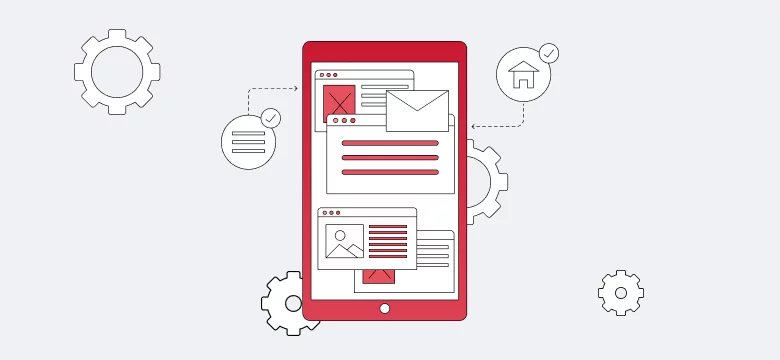How Your App’s Outdated Framework is Hurting Your Business
The technology industry is constantly growing and changing. What is new and innovative today might be old news within a short period of time. The same goes for frontend frameworks. Despite a multitude of different frontend frameworks competing on the market, only a few have passed the test of time. That’s good news for the frameworks that are still up-to-date and the products built with them. But what about the rest?
In this article, we will take a look at what qualifies as an outdated framework, what challenges come with it, and what you can do to tackle those challenges.
When is a frontend framework outdated?
A frontend technology becomes outdated when it is no longer worked on or maintained by the team that created it. This means:
- a lack of technical support,
- no updates or new versions, and
- nobody responsible for addressing any issues or bugs within the framework.
An old framework is basically a technology that is abandoned by its creators. The reasons are anything from being too costly to modernize or too complicated to maintain.
Examples of outdated frontend frameworks include AngularJS, ExtJS, Knockout.js, jQuery, Backbone.js, and Ember.js.
What challenges come with an old frontend technology?
If your digital product is built with a framework that suddenly becomes outdated, your product, and therefore your business, face numerous challenges. With no team backing the actual framework, your product is at risk of not being safe, reliable, and scalable. In fact, as House of Angular, we have conducted audits prior to migrations and we encountered situations where the value of the company was significantly underestimated, on average about 35%, due to them having outdated technology. All in all, your business will be spending more on a product that can do less.
Let’s take a look at all the risks your business faces with an old frontend technology.
A lack of safety and reliability
When a framework stops being supported and updated, it puts all products built with it at risk of numerous errors or worse, hacking. One of the main reasons for updating frameworks is to address any errors or code vulnerabilities that arise.
When a framework is not supported, there is no shield that protects the stored data. A lack of updates means that any errors or vulnerabilities that appear are not eliminated, but stay and grow stronger. Any data stored on the application is at risk of being stolen and sold. Your users and your business are more likely to be hacked as the framework becomes less and less trustworthy.
This means that the product your business relies on is becoming weaker and less reliable, which puts you in a vulnerable position. Not only is data at risk but so is your position on the market. An unreliable product will reduce the number of people that want to cooperate with your business, ultimately hurting your image.
Reduced accessibility
When everything around the product except its framework becomes updated, the product becomes less accessible to users. The application will become incompatible with new browser versions or mobile devices, both of which are continually updated.
Due to this incompatibility, users with updated browsers or mobile systems will not be able to access your product. And even if they do, chances are that some features of it will not work. This will significantly reduce the number of users, simply because the product is inaccessible for them. Even if they wanted to use the application, they won’t be able to.
Poor user experience
An application with an outdated framework will directly and negatively affect existing users. Users will have to deal with various challenges within the application. Even if your in-house developers do their best to maintain it, problems will arise.
Users of your product will:
- encounter frequent and repeated errors
- be at risk of getting their data stolen
- not be able to access the app on updated browsers or mobile devices
- have to use outdated UI and a lack of new features
All of this will result in loyal users turning to your competition. They will no longer trust your application, which will significantly impact your business.
Difficulty with scaling
A strong, modern framework enables easy application scaling. An outdated one does not. This is because the application is dependent on the framework in order to scale successfully. If your business is growing, your product should grow with it. However, an outdated framework will make it very challenging for that to happen.
Costly maintenance
When the creators of the framework abandon it, it then becomes the responsibility of your in-house development team. That means that not only do they have to maintain the whole application, but also the framework it’s built on.
The truth is that skilled, ambitious developers want to work on modern technologies. When your business will require them to work with an outdated framework, they will probably look for other opportunities. Your organization will then be forced to find new developers who will take their place. This will be challenging. Chances are that after a long recruitment process, you will end up with not very ambitious developers who will have the major responsibility of maintaining both the product and the framework.
Trusting those developers who are happy to work on outdated technologies is not only stressful but costly. Due to a lack of developers wanting to work on the application, you will spend a lot of unnecessary costs on the recruitment and onboarding processes, but also on their salaries. You will be left overpaying on average as much as 21% on a development team maintaining a product that does not benefit your business.
Can in-house developers migrate or rewrite an application?
Once you determine your product is built with outdated technology, you need to decide whether you should migrate or rewrite your code and what developers will carry out the process. Your in-house development team should not be in charge of the entire migration or rewriting process. This is because they are not familiar enough with the new technology you will decide on. In order for the migration or rewriting process to be carried out smoothly, your business has two options:
- Hire an in-house expert in the new technology that will take the lead
- Work with an outside agency that will handle the entire process
Whichever option you choose, the developer or team in charge of the migration or rewriting process needs to have expertise in the architecture of the new technology. That way, your product will be soon ready to be handed off to your users and offer them a rich experience that will keep them coming back.
Summary
When your product has a framework that is no longer supported or updated by its creators, your business is negatively impacted. These include dissatisfied users, difficulty scaling, costly maintenance, and the risk that your business will be valued less. In short, your product is costing you more money than its worth. The key to keeping your position on the market and growing your user base is modernizing your product technology. You can do that by either migrating your product to another framework or completely rewriting your code.



